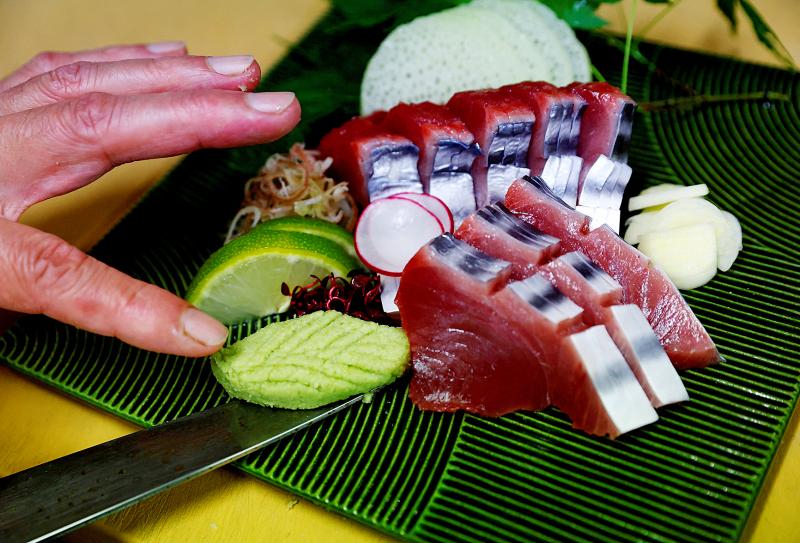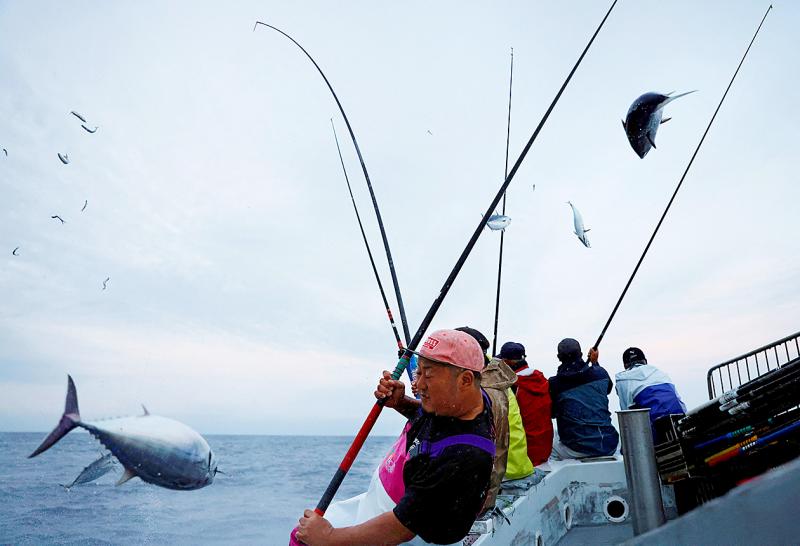For half a century, Takeo Nakajo has been catching katsuo, or skipjack tuna — indispensable in Japanese cuisine whether eaten raw, dried or used as a base for the broth.
But he and other fishermen in Kure, in Kochi prefecture in southwest Japan, have seen something worrying in the past two years — an unprecedented number of unusually fatty katsuo.
While heavier katsuo means more money, locals and experts say it indicates climate change and a risk for katsuo numbers already under threat due to growing demand and overfishing.

Photo: Reuters
“The fatty katsuo must have something to do with the water temperature,” said the 70-year-old Nakajo. “I have a sense of urgency thinking what if katsuo doesn’t come to the bay some day.”
Noriaki Ito, the head chef at a century-old restaurant Tsukasa in Kochi City, said he too had “never seen such fatty katsuo during this season of the year.”
This is worrying as changes in the sea and climate have already wiped out some other fish “including a shellfish called chambara-gai that used to be Kochi’s speciality,” Ito added.

Photo: Reuters
Originally from tropical waters, some Pacific katsuo migrate northward on a warm ocean current every spring, making Kochi’s arc-shaped bay a fertile fishing ground.
The average surface temperature of the bay in winter has risen by 2 degrees Celsius in the four decades to 2015, local fisheries lab data shows, and the fatter katsuo may be due to ample prey in the warmer sea.
But longer term, this warming may prevent mineral-rich water from rising to the surface, resulting in a drop in plankton and smaller fish to feed on, leading to fewer katsuo, said Hiroyuki Ukeda, an agroscientist and vice president of Kochi University.
This comes as Japan’s aging population is threatening the sustainability of local fishing and related businesses such as the production of dried and fermented katsuo, and wasabi horseradish — an eye-watering condiment tucked under fish in a piece of sushi.
In Kure, a district in Nakatosa town, many fishermen have gone out of business in the past three decades, said Takahiro Tanaka, a fourth-generation owner of a fishmonger who calls himself a “katsuo sommelier.”
“We can distinguish different tastes of katsuo, just like ordinary French farmers may savor subtleties of wine ... this place might be one of Japan’s last communities where katsuo is part of the daily culture,” he added.
“But without fishers, this won’t last,” Tanaka said.
Fisherman Nakajo also rued the aging community and fewer successors. “I asked my grandson if he would take over, but he’s now studying to work at a government office,” Nakajo said.
SUSHI CULTURE AT RISK
Overfishing has already hit catch numbers and dealt a blow to the fishermen in Kochi who have stuck to traditional single pole fishing methods versus large-scale seine fishing across the western Pacific.
Government data shows catch numbers in Kochi are only at a quarter of their 1980s peak.
“We have observed a catastrophic decline in landings over the last 10 years or so,” said Ukeda.
“A growing number of people fear we may no longer be able to eat katsuo in the near future if things continue like this.”
Production of katsuobushi, dried and fermented katsuo, often used as a shaved condiment over traditional Japanese dishes or as a broth base, is already suffering.
The number of katsuobushi manufacturers in Kochi has plunged from dozens some 40 years ago to only a few, said Taichi Takeuchi, who runs one in the town of Usa.
“I’m really unsure if we can continue this,” said Takeuchi.

Taiwanese chip-making giant Taiwan Semiconductor Manufacturing Co (TSMC) plans to invest a whopping US$100 billion in the US, after US President Donald Trump threatened to slap tariffs on overseas-made chips. TSMC is the world’s biggest maker of the critical technology that has become the lifeblood of the global economy. This week’s announcement takes the total amount TSMC has pledged to invest in the US to US$165 billion, which the company says is the “largest single foreign direct investment in US history.” It follows Trump’s accusations that Taiwan stole the US chip industry and his threats to impose tariffs of up to 100 percent

On a hillside overlooking Taichung are the remains of a village that never was. Half-formed houses abandoned by investors are slowly succumbing to the elements. Empty, save for the occasional explorer. Taiwan is full of these places. Factories, malls, hospitals, amusement parks, breweries, housing — all facing an unplanned but inevitable obsolescence. Urbex, short for urban exploration, is the practice of exploring and often photographing abandoned and derelict buildings. Many urban explorers choose not to disclose the locations of the sites, as a way of preserving the structures and preventing vandalism or looting. For artist and professor at NTNU and Taipei

March 10 to March 16 Although it failed to become popular, March of the Black Cats (烏貓進行曲) was the first Taiwanese record to have “pop song” printed on the label. Released in March 1929 under Eagle Records, a subsidiary of the Japanese-owned Columbia Records, the Hoklo (commonly known as Taiwanese) lyrics followed the traditional seven characters per verse of Taiwanese opera, but the instrumentation was Western, performed by Eagle’s in-house orchestra. The singer was entertainer Chiu-chan (秋蟾). In fact, a cover of a Xiamen folk song by Chiu-chan released around the same time, Plum Widow Missing Her Husband (雪梅思君), enjoyed more

Last week Elbridge Colby, US President Donald Trump’s nominee for under secretary of defense for policy, a key advisory position, said in his Senate confirmation hearing that Taiwan defense spending should be 10 percent of GDP “at least something in that ballpark, really focused on their defense.” He added: “So we need to properly incentivize them.” Much commentary focused on the 10 percent figure, and rightly so. Colby is not wrong in one respect — Taiwan does need to spend more. But the steady escalation in the proportion of GDP from 3 percent to 5 percent to 10 percent that advocates